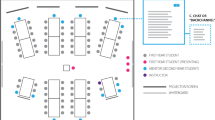Abstract
Remote learning solutions should account for important yet neglected aspects of contemporary learning environments, such as the activities that occur during mentor relationships, or the affect of community on cognition. It may be possible to partially replace the learning and motivation ordinarily provided by mentors and community through the marriage of a constructivist cognitive teaching model and contemporary delivery platforms, such as cognitive apprenticeship and multimedia. This approach is used in Convection Initiation, a multimedia training course designed to help weather forecasters interpret Doppler radar. The course is discussed in this paper to illustrate how cognitive apprenticeship can be used as a framework for designs that address the needs of a distributed learning environment.
Similar content being viewed by others
References
Austin, J.L. (1961).Philosophical papers. Oxford: Oxford University Press.
Bork, A. (1984). Producing computer based learning material at the educational technology center.Journal of Computer-Based Instruction, 11(3), 78–81.
Bransford, J.D., Sherwood, R.D., Hasselbring, T.S., Kinzer, C.K., & Williams, S.M. (1990). Anchored instruction: Why we need it and how technology can help. In D. Nix & R. Spiro (eds.),Cognition, education, and multi-media: Exploring ideas in high technology, 115–141. Hillsdale, NJ: Lawrence Erlbaum.
Brown, R. (1958). How shall a thing be called?Psychological Review, 65, 14–21.
Brown, J.S., Collins, A., & Duguid, P. (1989, January–February). Situated cognition and the culture of learning.Educational Researcher, 32–42.
Brown, J.S., & Duguid, P. (1991, February). Organizational learning and communities-of-practice: Toward a unified view of working, learning, and innovation.Organizational Science, (2), 40–57.
Casey, C. (1992, Autumn). Transactions and answer judging in multimedia instruction: A way to transact with features appearing in video and graphic images.Journal of Computer-Based Instruction, 19(4), 131–136.
Cognition and Technology Group at Vanderbilt. (1990, August–September). Anchored instruction and its relationship to situated cognition.Educational Researcher, 19(6), 2–10.
Collins, A., Brown, J.S., & Newman, S.E. (1989). Cognitive apprenticeship: Teaching the crafts of reading, writing, and arithmetic. In L.B. Resnick (Ed.),Knowing, learning, and instruction: Essays in honor of Robert Glaser, (pp. 453–494). Hillsdale, NJ: Lawrence Erlbaum.
Jonassen, D.H., Beissner, K., & Yacci, M. (1993).Structural knowledge: techniques for representing, conveying, and acquiring structural knowledge. Hillsdale, N.J.: Erlbaum.
Lakoff, G. (1987).Women, fire, and dangerous things: What categories reveal about the mind. Chicago: The University of Chicago Press.
Lepper, M.R., & Green, D. (1978).The Hidden Costs of Reward. Hillsdale, N.J.: Erlbaum.
Miller, G.A., & Gildea, P.M. (1987). How children learn words.Scientific American, 257(3), 94–99.
Novak, J.D. (1990). Concept maps and Vee diagrams: Two metacognitive tools to facilitate meaningful learning.Instructional Science, 19, 29–52.
Reigeluth, C.M., Merrill, M.D., Wilson, B.G., & Spiller, R.T. (1980). The elaboration theory of instruction: A model for structuring instruction.Instructional Science, 9, 195–219.
Resnick, L. (1988). Learning in school and out.Educational Researcher, 16(9), 13–20.
Rosch, E. (1981). Prototype classification and logical classification: The two systems. In E. Scholnick (Ed.),New trends in cognitive representation: Challenges to Piaget's theory, (pp. 73–86). Hillsdale, N.J.: Lawrence Erlbaum, 1983.
Spiro, R.J., Coulson, R.L., Feltovich, P.J., & Anderson, D.K. (1988). Cognitive flexibility theory: Advanced knowledge acquisition in ill-structured domains. In V. Patel (Ed.),Tenth annual conference of the Cognitive Science Society (pp. 375–383). Hillsdale, NJ: Lawrence Erlbaum.
Spiro, R.J., Feltovich, P.J., Jacobson, M.J., & Coulson, R.L. (1991, May). Cognitive flexibility, constructivism, and hypertext: Random access instruction for advanced knowledge acquisition in ill-structured domains.Educational Technology, 31(5), 24–33.
Spiro, R.J. & Jehng, J.C. (1990). Cognitive flexibility and hypertext: Theory and technology for the non-linear and multi-dimensional traversal of complex subject matter. In D. Nix & R.J. Spiro (Eds.),Cognition, education, and multimedia: Exploring ideas in high technology, (pp. 163–205). Hillsdale, NJ: Lawrence Erlbaum.
Spiro, R.J., Vispoel, W., Schmitz, J., Samarapungavan, A., & Boerger, A. (1987). Knowledge acquisition for application: Cognitive flexibility and transfer in complex content domains. In B.C. Britton & S. Glynn (Eds.),Executive control processes in reading, (pp. 177–199). Hillsdale, NJ: Lawrence Erlbaum.
Wilson, B., & Cole, P. (1992). An instructional design review of cognitive teaching models.Educational Technology, Research & Development, 39(4), 47–64.
Wilson, B., Heckman, B., & Wang, S. (1991).Computer-based cognitive apprenticeships: An example from weather forecasting. Paper presented at the 33rd International Conference of the Association for the Development of Computer-Based Instructional Systems, St. Louis, MO.
Wittgenstein, L. (1953).Philosophical investigations. New York: Macmillan. Vol. 1, 66–71.
Wlodkowski, R.J. (1989).Enhancing adult motivation to learn: A guide to improving instruction and increasing learner achievement, (pp. 172–177). San Francisco: Jossey-Bass.
Author information
Authors and Affiliations
Rights and permissions
About this article
Cite this article
Casey, C. Incorporating cognitive apprenticeship in multi-media. ETR&D 44, 71–84 (1996). https://doi.org/10.1007/BF02300327
Issue Date:
DOI: https://doi.org/10.1007/BF02300327




